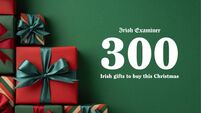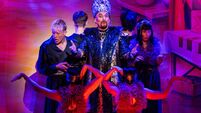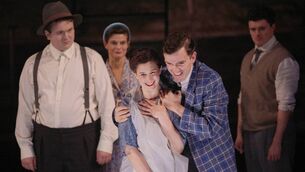Was Christmas telly better in the good old days?

Last year, Christmas telly was Brown all the way down. The highest rated Christmas Day broadcast on Irish television was Mrs Brown’s Boys: Mammy of the People, which drew 486,400 viewers – a 35 per cent share of the audience. In the UK, meanwhile, the seasonal ratings war was won by Call The Midwife, with an audience of 6.8 million. It was followed, inevitably, Mrs Brown’s Boys in seventh place (with 3.8 million).
This confirmed Brendan O’Carroll as a jolly bearded man who had made Christmas his own. But he didn’t have the day entirely to himself. Other big winners on December 25 included Fair City, which drew 257,000 for its Christmas special and EastEnders, racking up 267,000 Irish viewers on St Stephen’s Day.
There is, needless to say, little inherently Christmassy about Brendan O’Carroll dressed as a Finglas grandmother or Fair City and EastEnders pouring on the kitchen sink misery as though splashing gravy over turkey and ham. And yet these are the distractions audiences seemingly crave as the nights draw in and the tinsel comes out. Terrifying though it may be, the fact is Mrs Brown’s Boys is now a Christmas institution – a sort of end-of-pier Late Late Toy Show.
Faced with an uncomfortable truth – such as the fact viewers adore Brendan O’Carroll and his single entendres – it is tempting to conclude things were better in the old days. But is the dominance each December 25 of the Brendan O’Carroll fnar fnar fest truly a signifier of cultural decline? Or is it merely a case that, decade after decade, we are tuning into the same old seasonal tat with different wrapping paper?
To answer this question it is necessary to travel back in time. So let’s do just that. In Christmas 1983, the RTÉ Guide featured on its cover the quadruple threat of Twink, Ruth Buchanan, Bosco and Dermot Morgan hefting an oversized hurley. Inside, the editor welcome readers and shared with them some of mistletoe-hued treats to which they could look forward when sitting down to RTÉ over Christmas.
Pride of place went to the many top-class movies the national broadcaster had lined up. These included Martin Scorsese’s King of Comedy, a bittersweet meditation on success, failure, stifled dreams and the role of violence in society (decades later,it would partly inspire Joaquin Phoenix’s Joker). Next up was the Elephant Man, David Lynch’s biopic of Victorian freak-show survivor John Merrick. Oh and there was also the China Syndrome – in which Jane Fonda played a scientist trying to save the world from nuclear catastrophe. Cue viewers jingling into the living room to tuck into these “jolly” treats.
It wasn’t all glum Hollywood New Wave, however. Christmas Day featured a special 20-minute episode of Fortycoats, followed by the Paul Daniels Christmas Show – with guests including Hungarian acrobat family Five Star Endresz and husband and wife illusionists, the Pendragons. Pride of place on Christmas night meanwhile went to “Home For Christmas”, which promised “flickering firelight and good fellowship”. Described as an “informal gathering of some of Irish entertainment’s biggest names,” the line-up included Mary O’Hara, Frank Patterson, the Wolfe Tones, Twink and – slightly inevitably given that this was the 1980s– the Billie Barry Children.
Over on RTÉ Two meanwhile, the first broadcast wasn’t until midday. Here the fare was more high brow. Christmas at Pops featured John Williams, the Boston Pops Orchestra and the Tanglewood Festival Chorus. And the big movie was the not-terribly-seasonal “The Barrets of Wimpole Street”. In 2021, this sounds like a movie title rejected by Wes Anderson on the grounds of excessive tweeness. In 1983 it was something else. The Barrets of Wimple Street was a 1957 dynastic drama about a disabled woman trying to escape the shadow of a domineering father so that she could pursue her true love: poetry. Christmas cheer, it is safe to say, did not feature prominently.
A generation later, RTÉ’s Christmas movie selection was rather more on the nose. Last year’s big films included feel-good musical The Greatest Showman, Home Alone 2 and Peter Rabbit – none directed by Martin Scorsese or particularly concerned with the pain of existence. Television of course merely holds up a mirror to society. And Ireland in 1983 was a miserable place. Emigration was soaring, the economy in free-fall, the conflict in the North continuing to spiral. Every day was a bad news day. Dunlop in Cork had closed that September. Ford would shutter for good the following summer. Every time you turned on the television, a factory had either gone out of business or another bomb had rocked Belfast.
Was that why our Christmas TV was so bleak? Perhaps – though it is worth bearing in mind the going was equally po-faced on UK television. A perusal of the 1978 Radio Times confirms, for instance, that Xmas TV in Britain was every bit as serious as in Ireland. The cover of the magazine featured a rather alarming photograph of light entertainer Mike Yarwood as Santa Claus. The image raised all sorts of questions: Why is “Santa” taking off his beard? And what was with his scary google-eyed expression?
The actual schedules are a good deal less jolly than the grinning Yarwood. Among the delights awaiting audiences were Central European cartoons, Arthur Lowe reading a short story by Joan Aiken (this for Jackanory – the 1970s equivalent of CBeebies Story Time) and a lecture on the significance of composer Leonard Bernstein. The movie selections were eye-opening, too. The Christmas Day matinee was Dersu Uzala, by Akira Kurosawa – about a friendship between a Russian soldier and “woodsman with an uncanny instinct for survival”. It was neither based on a beloved Julia Donaldson book or featured James Corden voicing a comedy rabbit.
Were people more intellectual in 1978 than today? They almost certainly had greater attention spans, as their brains had not been frazzled by TikTok and YouTube.
And yet it’s worth remembering the present day King of Christmas, Brendan O’Carroll, is himself a throwback to the scruffy-at-the-edges comedy of the 1970s and 1980s. Mrs Brown’s Boys is immature, loaded with innuendos and with gags broader than a slap across the head with a Selection Box Curly-Wurly. Nobody would argue Christmas TV today is less serious-minded than was the case a generation ago.
And yet it is surely equally true that one of the biggest hits each December 25 is a guffaw-orgy that self-consciously tries to recreate the slap and tickle fervour of sit-coms from a simpler era. The past is a foreign country – especially when it comes to Christmas TV. But if the success of Mrs Brown’s Boys is any indication it’s a place many of us enjoying visiting, if only once a year.
- The Flight Before Christmas, BBC One; A new half-hour special from stop-motion maestros Aardman.
- debuts on BBC in late December, having already aired on Netflix in the US and across Europe (though not Ireland)
- Dermot Whelan and Doireann Garrihy “press the launch button on one hour of serious family entertainment”.
- The comedian-turned-chat show host returns for an Xmas special. “A master of improvisation, Tommy thrives on the adrenaline of surprises,” says RTÉ. “The result is conversations full of adventure and surprise, with people from all walks of life, some well-known personalities, some lesser so.”
- A celebration of Donegal country sensation Daniel O’Donnell as he marks a significant birthday.
- As inevitably as night follows day or a hangover a late evening, so there will be special Christmas Day and New Year’s Day episodes of Mrs Brown’s Boys.
- Una Healy and Loah welcome performances by some of Ireland’s leading artists from the Round Room of the Mansion House for a seasonal one-off.
- The cult children’s tale is brought to life by Mark Gatiss in an adaptation that also stars Tamsin Greig and Simon Callow.
- Olivia Colman narrates the latest animated retelling of a beloved Julia Donaldson children’s book, with Matt Smith as the eponymous worm.
- The Tipperary podcasters host RTÉ’s live New Year countdown from Dublin Castle with music from Picture This.
- New Year’s Day Jodie Whitaker is on her final victory lap as Doctor Who.







